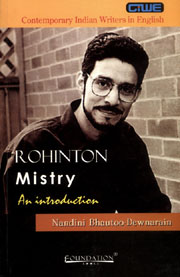Book contents
- Frontmatter
- Contents
- Series Editor's Preface
- 1 Introduction
- 2 The Local and the Universal
- 3 ‘Otherness’ in Mistry
- 4 Politics in Mistry's Fiction
- 5 Recurring Themes
- 6 Rohinton Mistry and Indian Writing in English
- Topics for Discussion
- Appendix A The 1975 Emergency
- Appendix B MISA
- Appendix C The History of the Bangladesh Conflict
- Appendix D List of Honours and Awards
- Bibliography
6 - Rohinton Mistry and Indian Writing in English
Published online by Cambridge University Press: 05 November 2011
- Frontmatter
- Contents
- Series Editor's Preface
- 1 Introduction
- 2 The Local and the Universal
- 3 ‘Otherness’ in Mistry
- 4 Politics in Mistry's Fiction
- 5 Recurring Themes
- 6 Rohinton Mistry and Indian Writing in English
- Topics for Discussion
- Appendix A The 1975 Emergency
- Appendix B MISA
- Appendix C The History of the Bangladesh Conflict
- Appendix D List of Honours and Awards
- Bibliography
Summary
The 1990s hold great interest for Indian writing in English. The decade witnessed the emergence of many literary talents. Author Gita Mehta attributes it to the expansion of the Indian middle class and their literary demands. John Mee argues that the emergence of Indian writing in English has a lot to do with the emergence of dynamic conditions of publishing in India and the facilities of market circulation which enable the target readership to have access to the texts (319).
It is also a fact that the need to re-imagine the nation through fiction has made itself felt in the last decade or so. This could be one of the reasons for the dynamic profusion of Indian, writing in English in the last decade as writers explore the multiple forms of the nation through fiction. In the critical field, the perception of the relative status of Indian writing in English as opposed to vernacular Indian writing has been the occasion of much polemic (Salman Rushdie's being the most notorious). The question of language and belonging and the positioning of the writer towards his material in language, place and time are important issues that have been addressed. In the case of Rohinton Mistry, he has made the literary choice to use English language to address the experience of the Indian Parsi. This experience located within a particular community is woven into a larger picture of India itself, and further, into the map of universal humanity.
- Type
- Chapter
- Information
- Rohinton MistryAn Introduction, pp. 111 - 112Publisher: Foundation BooksPrint publication year: 2006

